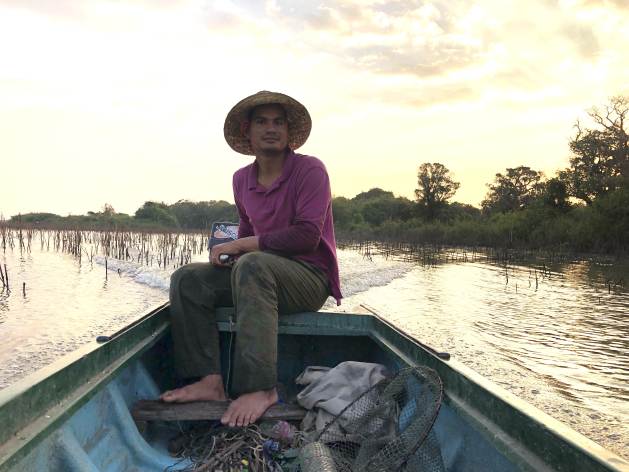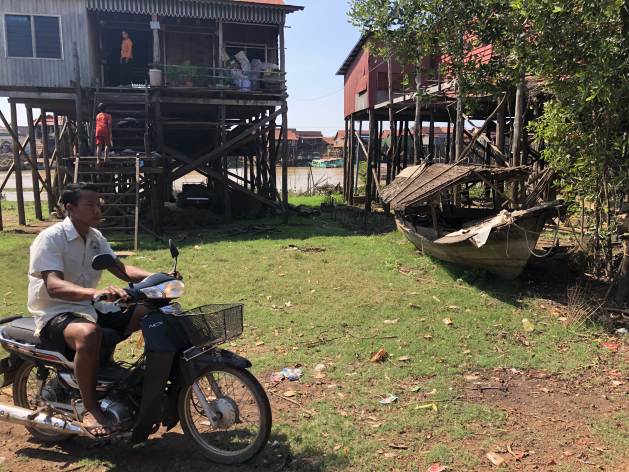
A Buddha statue keeps watch over the village of Kampong Khleang. Credit: Kris Janssens/IPS
By Kris Janssens
KAMPONG KHLEANG, Cambodia, Feb 21 2024 – Living in a floating village means embracing the rhythm of the ever-changing water. As I stroll through Kampong Khleang, flanked by wooden stilt houses lining sandy streets, I witness daily life unfolding. Alongside staircases, people prepare meals or run their little shops.
But actually, I’m walking at the bottom of a lake. In about six months from now, this will all disappear below the water surface. Residents will have to move to the highest floor of their houses and they will suddenly need a boat to go out.
Kampong Khleang is located on the shores of Lake Tonle Sap, in northwestern Cambodia, roughly 50 kilometers from Siem Reap and the renowned Angkor Wat temple. Owing to a unique tidal current, the village gets flooded once a year.

As the level of the Mekong river starts to rise in rainy season, the tributary called Tonle Sap is being pushed inland by the force of the water.
Lifeline
As the Mekong River’s level starts to rise during the rainy season, its tributary, Tonle Sap, is pushed inland by the force of the water. Following a meticulous scenario by Mother Nature, the lake at the end of the Tonle Sap overflows its banks and becomes five times as large, up to 250 km long and 100 km wide. From November onwards, the water recedes again.
This system is the lifeblood of this area and it creates a unique biodiversity. More than 1.2 million people in the region make their living from fishing.
But according to the Cambodian fisheries administration, fish stocks have declined by twenty percent in recent years. One of the causes is climate change. For several years now, the monsoon is less powerful and starts later than usual.
Eighty-three-year-old Laa recalls how her house was almost completely submerged during the summer. “As a child I had to go to bed by boat!” she shouts, giggling with joy at the memory. “But that’s all over now.”

Borei (24) would prefer to start his own business on land. Credit: Kris Janssens/IPS
Shallow Waters
It is five o’clock in the morning, one hour before sunrise. I go out to fish with 24-year-old fisherman Borei. With a headlamp guiding our way, he skilfully steers his outboard motor canoe through small bushes, sticking out of the water.
“More than an hour!” he shouts over the noise of the spinning propeller. He has to go further and further away from the village to find fish-rich areas.
We reach a cluster of trees, their roots more than a meter below the water surface. Borei paddles through this flooded forest and jumps into the water to check his traps.
From Father to Son
The catch is meager. A turtle can be sold, a little snake is thrown back into the water. Toads are clumsily trying to crawl out of the bucket. But Borei is mainly concerned with the fish: trei roah, a perch-like species, goes 2.5 dollars per kilogram.
Even for a dry season, the water level is exceptionally low, causing bigger fish to disappear. We return to the open water and enjoy the rising sun and a gentle breeze over the lake.
“We are fishermen from father to son, it’s our destiny,” Borei says shyly. He would prefer a more profitable job. “La-urng kook,” he says. The expression for “on land”, away from the water. Maintenance of mopeds, for example, or repairing mobile phones. But he has no investment money to start his own business.

Kampong Khleang: everything you see at street level disappears under water. Credit: Kris Janssens/IPS
“Not sufficient!”
Back in the village, the same story is repeated over and over again. There are fewer fish and everyone should learn to live within their means.
Two older ladies in a coffee shop, Laom and Juon, are discussing the situation as a local Statler and Waldorf duo. “At kroup”, they keep saying. “We don’t have enough.” Being 68 and 71 years old, they’re not so much worried about themselves, but more about the next generation.
Pooit (36) is cleaning the catch of the day. With strong strokes of a cleaver, she separates heads from slippery bodies. I’ve never understood why Cambodians prefer sitting on the ground for these kinds of jobs.
Biologists have been warning about the disastrous consequences of these dams, of which there are now eleven on the river. The hydroelectric power stations retain sediment, a sand layer containing micro-organisms that serve as food for larger animals
In a shrill voice she shouts orders to four children, crouched in a improvised circle, who help with the chore. Countless eyes of decapitated fish stare at me. The rhythmic tapping on the chopping blocks and the wriggling of struggling fish gives me a ghostly feeling. The sickening fish smell, which constantly blows through the village, combined with the stray pieces of trash, create a rough atmosphere.
“We work every day from early in the morning,” says Pooit, “we never have a day off.” But the result is very disappointing. “We only eat twice a day, mornings and evenings,” she says.
These fish are too small to be sold individually or per kilo. They are used to make the typical fermented fish paste called ‘prohok’. Once invented as a storage technique and now called ‘the cheese of Cambodia’ because of its penetrating smell.
Dams on the Mekong
Daney (34) remembers seeing big fish in the water next to the village. “They’ve all gone,” she says, “since the dams were built on the Mekong”.
Biologists have been warning about the disastrous consequences of these dams, of which there are now eleven on the river. The hydroelectric power stations retain sediment, a sand layer containing micro-organisms that serve as food for larger animals.
The dams also hold back water, which explains the lower flow rate. And larger fish, migrating to mate, cannot pass. This happens upstream on the Mekong, in Laos and northern Cambodia, more than three hundred kilometers to the east. But Mekong and Tonle Sap are two communicating vessels, and the negative effect can be felt as far away as Kampong Khleang.
No Future As Fishermen
Choon Phop (65) witnessed it all. He stopped working as a fisherman in 2016 and is now a bicycle repairer. “Many species have disappeared,” he says. “Illegal fishing techniques have destroyed the business, although there are now stricter laws.”
He refers, among other things, to electrofishing, a prohibited technique of using electric shocks in the water to affect the instinct and thus the movement of fish.
I sense more optimism from Takhoa, a 62-year-old retired fisherman, who has given his stilt house in Kampong Khleang to his son’s family. Now he lives in a small boat, surviving on vegetables and fish. In the reddish morning light he looks quite happy with his simple life.
Takhoa shares his insight like a teacher who talks to his student. According to him, the catch is poor because the low shrubs, a natural habitat for fish, are being cut on a large scale. Rice fields and other plantations are taking their place. “There are strict laws,” says Takhoa while he puffs on his cigarette, “but the police takes bribes to turn a blind eye.”
The Old Wise Man
A little later, mourning funeral prayers echo in the square in front of the pagoda. Large megaphones add a strange metal distortion to the dark sound. When the ceremony is over, I talk to the oldest monk Som Hoa (66), known by his epithet ‘grandfather’. I want to know how he sees the future of the village.
We sit on a bench in front of the meter-high golden Buddha statue. Som Hoa speaks slowly in a low, croaking voice.
“The problem is man-made,” he says. He cites illegal techniques and overfishing as the biggest causes. “They have to wake up and follow the rules. And then eventually everything will be fine.” He concludes with an old Cambodian saying: as long as there is water, there are fish.
